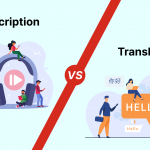
Transcription is the process of converting audio into a text form known as a transcript. It is the best way to make the audio or video recordings easily accessible. It can be done either automatically with software or manually by a transcriptionist.
Who is a transcriptionist?
A transcriptionist is a professional who transcribes audio or video files. Essentially, a transcriptionist must have the following qualities.
Patience: Transcription is not an easy process. Thus, the transcriptionist must be composed and have the patience to listen to the audio attentively to produce an accurate, meaningful, and clear transcript.
Language proficiency: The transcriptionist must understand basic language and grammatical nuances to ensure the transcript does not have grammatical, punctuation, and spelling errors.
Subject-matter expertise: The transcriptionist must have the specialized knowledge to use correct phrases, terminologies, and words while transcribing. For instance, only a professional who understands medical terms and procedures can transcribe an audio or video file with medical content.
Critical thinking skills: While a transcriptionist transcribes every word they hear from the audio or video file, it is essential to be attentive and have a keen eye for details. Sometimes, a word or phrase may be mispronounced by the speaker, but a transcriber with expertise and critical thinking skills will rectify it instantly.
Top 3 advantages of transcription
Clarity and Coherence: Often, the audience does not understand the enunciation or may miss out on hearing some words or sentences, which impacts their understanding of the idea presented in the audio or video. Thus, transcripts come in handy, and the audience can refer to them anytime for better understanding.
For the record: Transcription of an audio or video file helps record the critical information, links, etc. It can be easily shared as important reference material over emails or on social media.
Global reach: Businesses can communicate their ideas or concepts and connect with the audience worldwide by transcribing the audio or video file into multiple languages and sharing it with the audience across different geographies.
What are the advantages of outsourcing transcription services?
Quality is King: When clients choose a professional transcription service provider, they can be sure of receiving premium quality transcripts that are well-edited and free of basic language and grammatical errors. An in-house transcriptionist may not have the expertise needed to produce highly accurate and readable transcripts.
Budget-friendly: Today, most providers offer transcription service packages along with plenty of add-ons at a competitive price. Typically, transcription services are charged on a per audio minute basis. Outsourcing transcription work, therefore, proves to be more cost-effective than investing in training an in-house employee.
Peerless execution: Most translation service providers have a pool of professionals who have the experience and expertise to provide precise and detailed transcription. They deliver transcripts that have the best language quality and accurate technical phrases and terminologies. The client may also get the transcripts translated into multiple languages by the transcription service provider’s team of native speakers.
SEO-friendly: Many transcription service providers help clients improve their brand’s visibility by including specific keywords in the transcript. It boosts SEO and builds backlinks. As a result, the client can reach a wider audience with better content visibility.
On-time, every time: The transcription service provide strictly adheres to the client’s timelines. The client can expect quick turnaround times as the provider commits to the timely delivery of quality transcription services.
Formats galore: The client can submit any audio/video formats such as .mp3, .mp4, .wav, .wma, etc. The transcription service provider will be able to deliver the transcripts in .doc, .docx, .xls, .xlsx, .pdf, etc., as per the client’s preference.
After-sales care: An efficient transcription service provider always commits to providing the best transcription and after-sales services. If the client is not satisfied with the quality or accuracy, they always ensure to help the client with an updated and corrected version of the transcript.
What features should a transcription service provider have?
High-quality transcription: One of the reasons why people opt for a professional transcription service is to achieve the quality that they may not get with in-house transcription. Thus, the transcription service provider must deliver top-quality and precise transcription that is clear and easy to understand.
ISO/IEC-certified security systems: The transcription service provider must have a security infrastructure to protect the client’s data and assure confidentiality. Ideally, the providers who have achieved ISO/IEC certification for their security systems are more reliable and trustworthy.
Subject-matter expertise: The transcription service provider must have a team of highly experienced subject-matter experts to deliver high-quality transcripts that are accurate and relevant for the specific subject area.







Share your thoughts